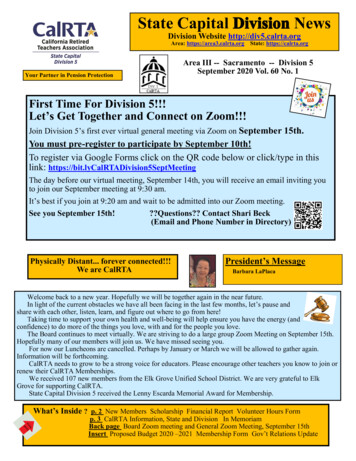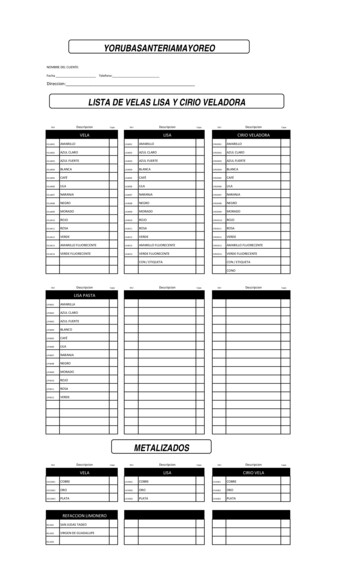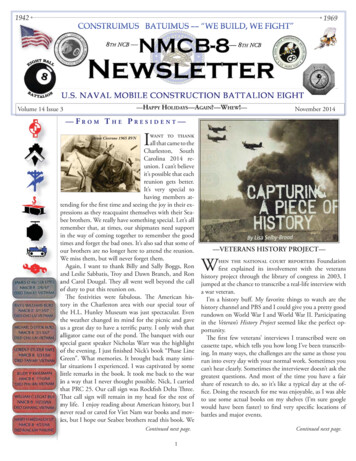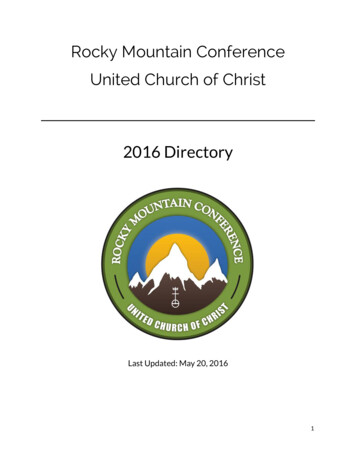
Transcription
“A fluid, fun, and insanely useful conversation for all hiring managers, HR professionals, and trainers.”Lisa Haneberg, author of 12 business books, including Coaching Up and Down the Generations90DAYS90WAYSOnboard Young Professionalsto Peak PerformanceALEXIA VERNON
Ensure a Return on Your Expectationschapter 6:Ensure a Return onYour Expectations“For, he that expects nothing shall not be disappointed,but he that expects much—if he lives and uses that inhand day by day—shall be full to running over.”Edgar CayceIf I had a dollar to invest for every time a manager has told me, “I hated to do it,but I had to let go” or “I had to put on probation,” I’d haveone robust Roth IRA by now. While I’ve elicited more than a few scowls by replying123
Chapter 6to such statements with a somewhat bemused, “What was your role in that failure?,”the question has always been genuine. In our companies—as well as our schools andour families—there is an epidemic of viewing underperformance or shattered expectationsas the fault of one person. Unfortunately, this is rarely the case. It takes two hardworkingpartners to build a successful marriage, a tribe to raise and educate a child, and anactive partnership between a company’s HR department, learning and development arm,and a young professional’s direct supervisor to get that young professional successfully tothe end of her first 90 days. Once we understand that we are as responsible for the successof a new hire as the new hire herself, then and only then can we learn, apply, and refinethe key strategies for ensuring our young professionals get to where they need to be.If you want greatness from your young professionals—and surely you do oryou wouldn’t be reading this book—you want to inspire it from day one. You do thisby communicating clearly what greatness looks like when it’s in full bloom, and youensure that your new hires understand your definition. You plant the seed for greatnessby speaking about your company/department/team as an incubator for the best andbrightest people, ideas, and projects. And most importantly, you observe how your youngprofessionals are growing and you shift your strategy based on what you observe—andwhat they tell you—they need.In one of my favorite books on collaborative leadership, As One, authors MehrdadBaghai and James Quigley use the relationship between a senator and citizens—asconceived and played out by the Ancient Romans—as an archetype to describe a wayfor leaders to elicit the best from their employees. According to Baghai and Quigley,“Citizens are filled with the notion of freedom and pride in their work. Their behaviors124
Ensure a Return on Your Expectationsare guided by the constitution and by their strong sense of belonging, thus they work hardto ensure that the community and what it represents are preserved. Equally important,senators help create an environment where citizens can make autonomous decisions. Noone tells them what choices to make; they understand how their decisions impact theoverall success of the community.”This is an effective way to think about how to engender success from young new hires.Our newest generation of workplace professionals grew up in a self-help culture that hassuggested they are entitled to and have a responsibility to derive meaning from theirprofessional work. As we have explored, our new young professionals have been workingcollaboratively from the time they were in preschool and are used to thinking about whatbest serves the needs and desires of a group. While this generation has been stereotypedas coddled, its members are used to having a voice in the decisions that affect them andthe rest of their team or “community.” As companies, when we can follow Baghai andQuigley’s charge to provide a “constitution” with principles and values for which youngprofessionals can operate and measure their success by, then we can “step back and allowthe citizens to come to decisions on their own.”Return-on-Investment (ROI) Vs. Return-on-Expectations(ROE)When we measure ROI, we are looking to measure the success of the “investment”(the money, time, and energy) we have made in an employee’s learning and growth.While plenty of metrics exist to capture how effective onboarding drives business resultsby reducing turnover, inefficiency, mistakes, and so forth—I believe that attempting to125
Chapter 6measure your ROE, particularly around onboarding, is a more effective means for assessingsuccess and strengthening your practices. What do you expect employees to be able “to do”by the end of their 90 days? Make 40 sales calls per day? Receive good to excellent ratings on“smiley sheets” after each of their weekly presentations? When you are able to answer howsuccess will be achieved for your young professionals—and ultimately for yourself—youwill be able to develop an onboarding action plan that gets your expectations met. Youwill also ensure that HR, training, and management are all cogs that are part of the samewheel: new hire success.DAY7BE TRANSPARENTTransparency is one of the key catalysts for sustainable workplace success. Aswe explored in chapter 3, this generation of young professionals thrives with a syllabus.They like to know what they are responsible for (chief responsibilities and accountabilities),when key assignments are due (project deadlines), and how grades will be determined(means for assessment).Transparency makes a great workplace core value. And companies with honestand accessible customer and employee reviews, pay scales, and promotion pathwaysconsistently report higher profitability, employee engagement, and retention. Transparencyis equally important when it comes to employee expectations, particularly for young newhires. Let your new hires know what you expect, and make yourself a partner in helpingthem get there.While HR and training want to set their expectations during their first touch with anew hire, if you are a manager or direct supervisor, your initial conversation about your126
Ensure a Return on Your Expectationsexpectations for your young professional should happen by the end of the first week.During this conversation, you want to clarify exactly what you expect from your new hirein each of the following P’s. Questions to ask yourself in order to help you identify theexact pieces you want to convey include:Professionalism(Note: Some of these you may have addressed prior to the first day. However, it’s nota bad idea to revisit them again.) What is appropriate workplace dress? What is the appropriate use of technology, particularly social media? Can employees take personal calls in the workplace? What kind of relationship can young professionals enjoy with managersoutside of the workplace? Can colleagues date? If so, must they be in different departments? Have lateralpositions? Report the romance to HR?Performance What are the three to five key indicators of outstanding performance inthis position? What skills and behaviors do you want to see evidence of? What are key benchmarks in performance that must be met in the first90 days?127
Chapter 6 What are key project deadlines that must be hit in the first 90 days? How are promotions and raises decided?Problem Solving What are proven best practices for handling the “typical” problems thatsomeone in this role will encounter? How should a young professional navigate a problem? At what point should asupervisor be brought in? What are company practices for handling internal conflict or conflict with acustomer/stakeholder should it emerge?Passion What’s an appropriate workplace attitude? What values do successful employees carry into their work? How can young professionals demonstrate creativity and innovation? How can new hires best incorporate themselves within (while activelyshaping) company culture?The way you frame conversations about expectations is just as important ascommunicating what you expect. By asking yourself the questions above, you will128
Ensure a Return on Your Expectationsundoubtedly hit upon company and individual policies and procedures for which thereis no wiggle room. At Doug’s Doodads we have a zero-tolerance policy for violence inthe workplace. We define violence as the physical, sexual, verbal, or emotional abuse ofan employee, customer, or stakeholder. Fair enough. Yet I suspect your company (andparticularly you) have a lot of “soft” expectations, particularly in the areas of attitude,engagement, problem solving, and innovation for which there are not clear guidelinesor means for assessment. These areas—what I like to call the “connective tissue”—will determine whether your young professionals will have the muscle, strength, andendurance to stay running (for while 90 days will get them ready for the race, ultimatelyit’s a marathon and not a sprint). As we will next explore, if we want a champion athleteor star performer, we need the person in question to be a pivotal part of designing theaction plan.DAY7CO-CREATE MEANS FOR ASSESSMENTIn conjunction with articulating your expectations in as much detail aspossible, you want to discuss how you will measure achievement in each of the four Ps.To obtain buy-in to your expectations and create the foundation necessary for a youngprofessional not only to meet but also to exceed expectations, solicit their ideas for howsuccess will be measured. To return to our previous metaphor, get clear on what youryoung professional or “athlete” needs to stay hydrated, flexible, strong, and fast.Some key questions to ask are: How can I best support you in achieving ?129
Chapter 6 What is the balance between structure and freedom you need to consistentlygive your best? How are you best able to listen to and incorporate feedback? What kind of formal and informal assessment has previously worked wellfor you? What are the things I should avoid doing at all costs that you know shut youdown and impede success?Strive to show up to conversations with the sole agenda of co-creating a viable,results-oriented plan and follow-up strategy. Ensure that you are asking questions thatfacilitate insight for your employees, particularly young new hires who thrive in such alearner-centered environment. By doing so, your job becomes easier and your employeeswill achieve greater success—for they will have taken ownership over their own learning.DAY7FIND YOUR EMPLOYEE’S MOTIVATORSIn one of my favorite books on motivation, Drive, author Daniel Pinkdifferentiates between extrinsic and intrinsic motivators and provides numerousrecommendations for how leaders, managers, and companies can and should shift fromthe former to the latter. He suggests that if the overall work that your young professionalnew hire is engaging in is in any way stimulating, creative, and requires autonomy,consistently relying on carrots to drive performance and results ultimately yields one ofthese “Seven Deadly Flaws”: They can extinguish intrinsic motivation.130
Ensure a Return on Your Expectations They can diminish performance. They can crush creativity. They can crowd out good behavior. They can encourage cheating, shortcuts, and unethical behavior. They can become addictive. They can foster short-term thinking.To understand how to hook into intrinsic motivators to catalyze an employee’sdrive, it’s important to again reference Pink and draw an important distinction betweenmotivation and inspiration.Motivation Vs. InspirationMotivation is the individual force within a person that makes her want toshow up to life at 100 percent to perform at 100 percent. Inspiration, on the other hand,is what draws out a person’s motivation. As managers, trainers, coaches, or consultants,we cannot motivate someone. Something is either a motivator for someone or it is not.What we can do is identify what specifically motivates each of our employees and stepinto the role of inspirer by enabling our people to harness their motivators in their work.While as you know I’m not a big fan of stereotypes, I do think it’s important tounderstand what members of each generation typically value most, so that we as workplacemanagers and leaders can harness this enthusiasm to produce the results we seek. As I’ve131
Chapter 6shared with you previously, our current generation of young professionals particularlyvalues work where they feel like they are making a positive social and environmentalimpact, the ability to learn and grow in their workplaces, and the ability to achieveintegration between work and life. They also like to be acknowledged in front of othersfor exemplary work. In other words, it’s not the trophy. It’s the ceremony where theyreceive the trophy that matters!Therefore, consider how to inspire your young professionals via peer recognition.Sodexo is one company that has figured out how to do this well. Sodexo’s brandambassadors participate in the Brand Ambassador of the Month (BAM!) program.While the person who has done the best job promoting Sodexo in their onlinecommunities is simply recognized on the team call, Senior Director of TalentAcquisition, Sherie Valderrama, says that peer recognition does an incredibly powerfuljob of tapping her staff ’s desire to be honored. “When we announce the winner on ateam call,” Sherie explains, “that person doesn’t just receive congratulations on the phone.It’s not uncommon for 40 tweets to go out from the Sodexo community in a matter ofminutes acknowledging the person. That goes a long way with our people.”Remember too that motivators will also be shaped by the industry you are in. Forexample, in the leadership and career development program I lead for new nurses,approximately 80 percent of each cohort I work with—irrespective of hospital orspecialization—report that feeling competent is one of their biggest motivators to stayingengaged in their work. When I have worked with other groups of young professionals, suchas MBA students or new business associates, one of the motivators I typically encounter isthe ability to create solutions for problems people have previously put up with.132
Ensure a Return on Your ExpectationsThere is no surefire recipe for sourcing your young professionals’ motivators. Youcan have them do one of the many motivation styles assessments that exist. You can havethem identify the times in their life they have been most motivated by the academic,philanthropic, or professional work they were doing and have them explore commonthemes that were present. And most importantly—and most simply—you can ask. Whatgets you most jazzed? What can I do to help you harness your motivation in the work thatyou do? Or if you suspect there is some barrier getting in the way—particularly as youcreep into your second or third month of work together, a time when the initial walkingon egg shells to impress and people please stops—What barriers are getting in the way ofyou feeling motivated? How can we partner together to remove them? Then, make sure youare applying this information in how you are assigning work to your young professionals:checking in and holding them accountable; acknowledging them when they have beensuccessful; troubleshooting with them when they get stuck; and pushing them to the nextlevel of success when they are ready for a new challenge. Not sure how to solve all of thosepotential challenges? This question does have an answer. And it’s coaching.DAY14CREATE A COACHING CULTUREAs we have explored so far in the onboarding tactics in this chapter, whetheryou are looking to create a system for assessment or learning how to identify your youngprofessional’s motivators, the key to having conversations that lead to results is to coach.While I’m a bit uncomfortable privileging one onboarding tactic over another, if you wereto play with only one of our 90, this would without a doubt be the tactic I’d want you touse. For when new hires are open to being coached and can apply it, together there reallyis no problem that cannot be bulldozed through.133
Chapter 6While there are as many different definitions of coaching and approaches to doingit as there are people who profess to coach, we’re going to explore what I have found tobe the most simple way to conceptualize coaching. Then, we will look at how to do it aseffortlessly, efficiently, and consistently as possible with your new young professionals.Coaching is a confidential, empowering, and catalytic relationshipbetween a coach and coachee(s) to facilitate learning and growth, improveperformance, and close the gap from where coachee(s) are to where theyaspire to be.When someone steps into the role of coach, she begins by establishing that theconversation is confidential and then seeks to learn as much as possible about wherethe person receiving the coaching is coming from. To be successful as a coach, whethercoaching a young professional or a senior leader, one must let go of an agenda for theperson receiving coaching, use curiosity to ask questions that promote critical thinkingand insight, listen to what is being said (and not said), and adapt her approach to bestfit the needs of who is being coached. Coaching conversations are often scheduled toallow the person receiving coaching to show up as prepared as possible, yet they canbe impromptu as long as both parties are game. Because young professionals tend to beadaptable, multitasking, and comfortable with real-time feedback due to their immersionin online media, they are the generation perhaps most amenable to impromptu coaching.For coaching to yield results, the coach must enable the person receiving coaching todefine the focus of the conversation as early as possible. This is pivotal, particularly foryoung professionals who may not be familiar with coaching. For those new to receivingcoaching, it can be tricky to identify what the goal is and it can be easy to get wrapped134
Ensure a Return on Your Expectationsup in story. For example, while your new hire might need to vent for a few minutes abouther overwhelming feelings, you both will have a more productive conversation if shecan identify that she would like to walk away with a couple of strategies to improve timemanagement. Other times the focus will be somewhat ephemeral—getting comfortablein one’s new role. When the coachee identifies a focus without clear means for assessingwhether the goal has been met, a coach wants to unpick the aim. How will you know whenyou are comfortable? What will being comfortable look and feel like to you? What will bethe payoff?Once an agenda is created, the coach asks questions to help coachee(s) tap into theirown wisdom and find the answers to get them where they want to go. You should resistthe temptation to take answers at face value, knowing that people often see symptomsof problems rather than their sources. Therefore, your questions should push coacheesbeyond their own assumptions and help them explore possibilities they may have neverpreviously considered. Just as importantly, you help people see themselves as creatorsof their own experiences. Even when people don’t like the choices before them, a choicealways exists—even if it’s simply about how to process and archive an experience. Hereare some effective questions for your coaching toolbox:Getting Unstuck If you knew the answer, how would it begin? What are you pretending not to know? How can you remove the pressure of getting “the right” answer so that you areopen to recognizing your answer?135
Chapter 6 How can I support you in brainstorming some possibilities? What would choosing the path of least resistance look like?Empowering Where have you been successful? What’s your role in this? Who are you called to be in this situation? How might this be an opportunity for you to play “a bigger game”? Who will you be as a result of this achievement?Thinking About Your Own Thinking How long have you been thinking about this? If you were to look at as a symptom of something deeper, whatcould be its source? If keeps showing up, what does this suggest about what you areputting out into the world? How can you shift this obstacle into an opportunity? What’s the lesson you are ready to learn, once and for all?136
Ensure a Return on Your ExpectationsDuring a coaching conversation—which usually lasts 20–45 minutes—you dancebetween asking questions, mirroring back what you are picking up, and devising action.As a coach you are never telling someone else what to do. You may share best practicesyou have seen work, or offer up your own ideas when brainstorming. For learning to stickand facilitate shifts in thinking, behavior, and results, coachees need to settle on their ownanswers and articulate what they will do with the content of the conversation.Therefore, it’s incredibly important as a coach to bring a coaching conversation to aclose by allowing the person receiving coaching to share back what has been most usefulfrom the conversation and how she will apply it moving forward. As we will explore in moredetail in our next tactic on feedback, you also want to be clear on follow-up, assessment,and how you can support the achievement of results. This can all be accomplished in a fewsimple questions. Tell me, what are you taking away from our conversation? What has beenmost useful for you about what we’ve explored? Once the person has sufficiently answered,then you can follow up with a question or two about next steps. How will you transferwhat you are taking away into action? How can I support you in meeting these objectives?Let’s take a look at how to apply these coaching principles in real world practice.In the following scenario, “Nurse Nancy” is finishing her fourth week as a new nurseon the medical-surgical floor of an urban hospital. Like most recent graduates, Nancyis being paired with a preceptor—a veteran nurse who is sharing her patient load withNancy and helping her learn everything she needs to know about her role, before flyingsolo at the end of her first six to eight weeks on the job. For those unfamiliar with currentnursing culture, a new nurse grad can expect to work three to four 12-hour shifts per week,carry a patient load of initially two, and eventually up to six patients. And on a med-surg137
Chapter 6floor where most new nurses land, they will spend the majority of a shift on their feet,running between patient rooms, making phone calls to doctors, consulting with families,and learning new technology and charting systems. Many of these new nurses don’t get abreak. Many also rotate between day, night, and graveyard shifts, meaning they may notbe able to sleep between shifts and are showing up to work tired.In the role play we’re going to explore, Nancy’s preceptor, Paula, has noticed thatNancy is no longer the bright-eyed, overeager, perfectionist nurse she was paired with amonth earlier. She’s not sure what is going on with Nancy, but she is worried about her—and of course how her changes in attitude and energy might be shifting her behavior.Already she’s noticed that one of her charts had too much explanation (nurses are askedto chart by exception) and that some of her words were unclearly abbreviated. Let’s seehow Paula, a skilled coach, is able to help her new hire unpick what has been going onand explore ways to move from grad to great—following the best coaching practices wedetailed in the previous pages.Preceptor Paula Coaches Nurse NancyPaula: Nancy, thank you so much for taking a moment to chat with me. Isthis still a good time? (1)Nancy: Absolutely. It feels really good to get off my feet.Paula: Yes, I think it’s fair to say we’re both pretty exhausted. Tell me. Howhas your day been going?Nancy: All right, I guess.Paula: What have been your high points of the shift? (2)138
Ensure a Return on Your ExpectationsNancy: I feel like I’ve been doing a good job balancing my timebetween patients.Paula: I agree. Your time management skills have definitely grown in the lastfew days. (3) What strategies have enabled you to do this? (4)Nancy: Taking a few minutes at the start of my shift to map out what I needto get done and the best order to do it all in. Also, dividing tasks into shortterm urgent, long-term urgent, short-term non-urgent, and long-term nonurgent has really helped. I used to never get to any long-term non-urgent,and now I make sure I slip these in once I’ve gotten the short-term urgenttasks taken care of.Paula: This is terrific, Nancy. I’m really impressed. (5)Nancy: That means a lot. Sometimes I feel like I’m not really working at mybest. I have a tendency to repeat in my head everything I’ve done wrong andnever remember anything I did that was right.Paula: I’m not sure I know what you mean. I see a lot of potential in you.Could you tell me a little bit more about that? (6)Nancy: I’ve just been second-guessing myself a lot lately. That’s actually whyI’ve been wanting to talk to you. I’m sure you’ve noticed. I don’t feel like I’mthe same person I showed up as a few weeks back. I don’t know how to getback to my old self, and I really want to.Paula: Is that what you’d like to walk away with today? A plan for gettingback to your “old self?” (7)Nancy: That would be amazing if that could happen. Yes.139
Chapter 6Paula: When you think about your “old self,” who do you see? (8)Nancy: That’s a good question. I guess it’s less about seeing. I mean sure,I had a smile on my face. I couldn’t wait to get to work. But more thananything, I just felt like I was prepared for this experience. I wasn’t inthis alone.Paula: What has gotten in the way of you feeling like you have a team to turnto when you are unsure of an answer or need some verification? (9)Nancy: I guess it happened after Sarah [the charge nurse on the floor]heard me reading an incorrect dose to a doctor on the phone. She pulledthe phone out of my hand, told the doctor I had made a mistake, and sincethen I’ve just felt like I was walking on eggshells around her. Kind of aroundeveryone. I haven’t wanted to ask for help. I keep making mistakes. And alot of days I just feel like I’m an idiot. And it’s becoming somewhat of a selffulfilling prophecy. Now, I’m getting sloppy with my own charts. I know betterthan that. I just can’t shake the feeling that I disappointed Sarah. And now,everyone else.Paula: I can tell that thinking you’ve let someone else down is really hard foryou. How might forgiving yourself start a chain reaction of positive results inthis situation? (10)Nancy: It would be huge. I would be able to get out of my head, stay in themoment, stop making such careless mistakes, and just feel better overall. I’dalso probably be able to sleep better when I finally make it to bed.Paula: How will you make this commitment to yourself—once and for all?(11)140
Ensure a Return on Your ExpectationsNancy: When I hear my inner critic pop up, I’m going to remind myself thatI am a smart and capable nurse. I literally just need to repeat that to myselfagain and again until that message sticks. And I can ask myself, “What didI do right today?” The more I put my attention to that, the more I will keepdoing things more and more right.Paula: How can you apply what you have learned with Sarahmoving forward? (12)Nancy: Oh my goodness, not be embarrassed to ask for another set of eyesto read over something if I’m at all unsure. I will ask for help when I needit. And if I do make a mistake, I’m going to own it in the moment and not letmyself wilt. You know, until we started talking about this I don’t think I evenrealized how this one incident has seriously undermined me almost everyday for the last few weeks. I realize now that if I could have just said, “Sarah,I’m sorry for misreading the number. Thank you for having my back,” I wouldhave felt like I stepped into my power rather than away from it. And I thinkthat’s the key to me feeling competent. Standing tall in difficult situationsrather than shrinking from them.Paula: You are a powerful person, Nancy. When you believe that, yourenthusiasm and ability to make a difference are infectious. We’re here foryou. You just have to let us know how we can help. Now, I know we need toget back out on the floor, so let’s start to bring everything we’ve talked abouttogether. What has been of most value to you during our conversation today?(13)Nancy: Having the space to talk this all out. Like I said, I knew that I wasn’t141
Chapter 6myself but I really wasn’t sure why. Recognizing that the way I store anexperience is as important as the experience itself is a really big “aha” forme. Also, learning how to stop myself in the midst of a negative thoughtpattern. And of course, making the commitment to reach out to my team. Youall are here for me.Paula: How can I best support you in applying what you learned today? (14)Nancy: When we have our check-ins, it would be really great if you could justask me how my inner critic is doing. Also, I’m going to pay attention to mycharting. Make sure that when I’m doing it, I’m really focused on my writing.No more abbreviations or unnecessary explanations. If you could look at mynext few and tell me how they look, that would be really useful.Paula: You got it, Nancy. I can’t wait to see how you continue to evolve in ournext few weeks together. I think your future is very bright. (15)The Core Pieces of the Coaching Conversation(1) Asking for permission(2) Asking a possibility-centered question to empower(3) Mirroring back success(4) Facilitating learning and growth(5) More affirmation(6) Asking for clarification(7) Setting agenda142
Ensure a Return on Your Expectations(8) Facilitating learning and growth(9) Listening to what is not being said(10) Facilitating learning and growth; moving to action(11) Facilitating learning and growth; moving to action(12) Facilitating learning and growth; moving to action(13) Recapping(14) Next Steps(15) EmpoweringDAY21DO IT EARL
In one of my favorite books on motivation, , author Daniel Pink Drive differentiates between extrinsic and intrinsic motivators and provides numerous recommendations for how leaders, managers, and companies can and should shift from the former to the latter. He suggests that if the overall work that your young professional










